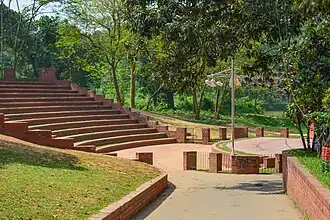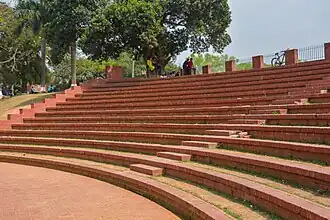Selim Al Deen Muktamanch
সেলিম আল দীন মুক্তমঞ্চ | |
Muktamanch | |
 View of Muktamanch from the entrance | |
| Location | Savar Upazila, Dhaka Division, Bangladesh |
|---|---|
| Coordinates | 23°52′43″N 90°16′15″E / 23.8787°N 90.2708°E |
| Owner | Jahangirnagar University |
| Type | Amphitheatre |
| Capacity | 1500 |
| Surface | Ceramic brick |
| Current use | Drama, cultural events |
| Construction | |
| Opened | 1980 |
| Years active | 1980–present |
| Architect | Alamgir Kabir |
Selim Al Deen Muktamanch (commonly known as Muktamanch) is an amphitheatre at Jahangirnagar University in Savar, Bangladesh. It is located on the slope of a mound to the east of the university's Student–Teacher Center.[1] It is the first open-air theatre in South Asia to be built in the style of Ancient Greece amphitheatre.[2] It was long referred to simply as "Mukt Manch", after which it was officially named posthumously in honor of its master planner, Selim Al Deen.[2][3] Muktamanch opened in 1980 with a production of the play Shakuntala.[4]
Design
.jpg)
To accommodate both the academic needs of the Department of Drama and Dramatics at Jahangirnagar University and the theatrical culture emerging on campus, a plan was conceived to establish a purpose-built, professional-grade stage. The initiative for the construction was spearheaded by Selim Al Deen, the founding chairperson of the Department of Drama and Dramatics.[2] In addition, several prominent figures, such as Mustafa Monwar, Nasir Uddin Yusuf Bachchu, and Zillur Rahman Siddiqui, contributed to the planning and development of the theatre. The architectural design of the theatre was entrusted to filmmaker and architect Alamgir Kabir.[2]
The design and site selection for the stage were heavily influenced by the topographical resemblance between Jahangirnagar's landscape and the rugged terrains of ancient Greece. The vision was the creation of a performance space modeled after the open-air amphitheatres of ancient Greece.[2] Such theatres were typically built by carving into uneven valleys, creating a sloped area where the main stage, or orchestra, was positioned, and spectator seating was arranged along the natural incline of the surrounding hills. Similarly, the open stage at Jahangirnagar was constructed on lower ground with three open sides in front of the central stage, inspired by the design of the ancient Greek theatre at Epidaurus.[5] The open-air stage at Jahangirnagar University is the first structure in Bangladesh[1]—and indeed in Indian subcontinent—constructed in the ancient Greek open-air style.[2][4]
The entire structure, including the tiered seating carved into the natural slope, is constructed using red ceramic brick masonry. The architectural design ensures that performances on stage are both audibly and visually accessible from every point in the audience seating without the aid of artificial sound amplification or lighting systems.[2] An iron framework is installed above the central stage platform to facilitate the suspension of fabric coverings and lighting equipment as required.[1] The audience seating consists of 14 ascending tiers, accommodating up to 1,500 spectators simultaneously.[2]
-
 The Student-Teacher Centre in the background.
The Student-Teacher Centre in the background. -
 One side of gallery from ground
One side of gallery from ground -
 Entrance from cafeteria
Entrance from cafeteria
History
Although theatrical performances are most commonly staged here, Muktamanch at Jahangirnagar University serves as the central venue for nearly all cultural activities on campus.[1] Annually, approximately 250 events are organized here, including national debate competitions,[6] departmental reunions, graduation ceremonies, concerts, theatre festivals, and celebrations such as University Day.[1]
The first university-based theatre troupe in Bangladesh, Jahangirnagar Theatre, inaugurated Muktmanch in the early dawn of 1980 with a performance of Shakuntala. Actors such as Shahiduzzaman Selim, Faruque Ahamed, and Subhasish Bhowmik began their theatrical journeys by performing in this production.[2] In 1991, during a concert at the open stage, rain started falling shortly after the band Different Touch began their song "Sraboner Meghgulo Joro Holo Akashe". The same phenomenon repeated during another performance of the song at the venue in 1992.[7]
References
- ^ a b c d e "অবহেলায় নষ্ট হচ্ছে দেশের প্রথম মুক্তমঞ্চ" [The country's first open air theatre is in demise due to negligence]. Jago News 24 (in Bengali). 2015-08-25. Retrieved 2024-10-22.
- ^ a b c d e f g h i Khan, Faridur Reza (2022-08-06). "জাবির তারকাগর্ভা সেলিম আল দীন মুক্তমঞ্চ". Bangladesh Journal (in Bengali). Retrieved 2024-10-22.
- ^ "একজন শেকড় সন্ধানী সেলিম আল দীন" [Salim Al Deen, a root seeker.]. sarabangla.net (in Bengali). 2018-08-18. Retrieved 2024-10-22.
- ^ a b Suman, Ahmed (2018-01-12). "অনন্য জাহাঙ্গীরনগর বিশ্ববিদ্যালয়" [Unique Jahangirnagar University]. Jugantor (in Bengali). Retrieved 2024-10-22.
- ^ "ভাস্কর্য কথা বলে" [Sculpture speaks.]. Jago News (in Bengali). 2015-07-04. p. 2. Archived from the original on 2018-03-12. Retrieved 2024-11-12.
- ^ "'National Debate Fest-2023' at JU on Thursday". Bangladesh Sangbad Sangstha. 2023-10-10. Archived from the original on 2023-10-11. Retrieved 2025-06-07.
- ^ "'শ্রাবণের মেঘগুলো জড়ো হলো আকাশে' গানটির সৃষ্টি যেভাবে" [The Origin of the Song “Shraboner Meghgulo Joro Holo Akashe”]. Prothom Alo (in Bengali). 2023-08-02. Archived from the original on 2023-08-02. Retrieved 2023-08-02.